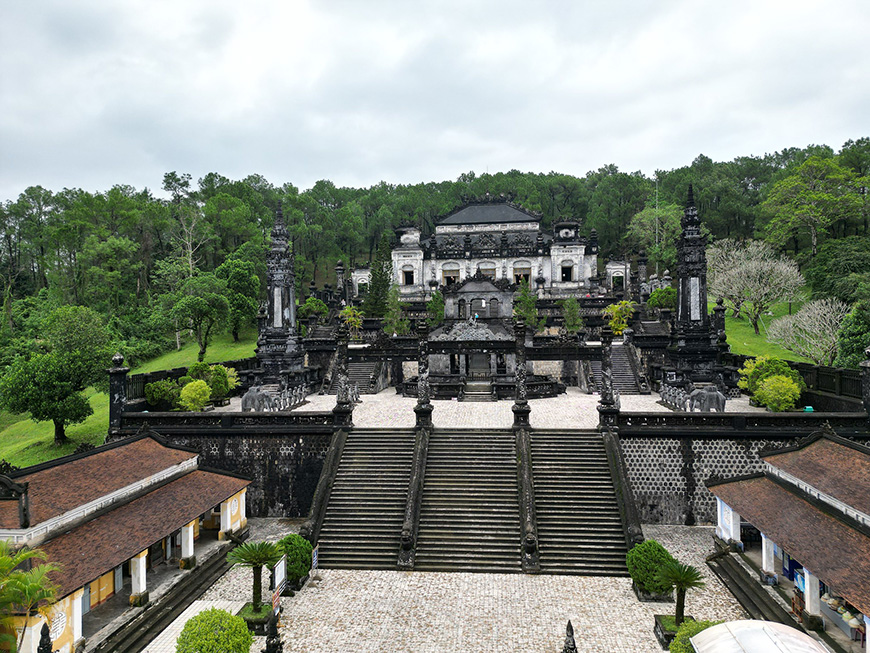
Aerial view of Khai Dinh's tomb - Source : Mr Linh's adventures
Nestled in the lush hills along the Perfume River, the tombs of the emperors of Hue offer much more than just a tourist attraction. These majestic mausoleums, silent witnesses of Vietnam's history, open a window into the culture and spirituality of a fascinating country.
The Legacy of the Nguyen Dynasty
The Nguyen Dynasty, which ruled from 1802 to 1945, was the last imperial family of Vietnam. Under their reign, Hue became the imperial capital, a center of political and cultural power.
The Nguyen emperors, eager to leave an indelible mark of their reign, built these grand tombs, true palaces for the afterlife.
Out of the thirteen Nguyen emperors, seven have their tombs in Hue. The four most famous and essential ones are those of Tu Duc, Minh Mang, Khai Dinh, and Gia Long.
Did you know? The entire complex of monuments in Hue, including these tombs, has been a
UNESCO World Heritage Site since 1993.
Architecture Laden with Meaning
Each tomb is an architectural masterpiece, blending Vietnamese, Chinese, and European influences. From the monumental entrance to the inner pavilions, each element holds a particular significance. The dragons, phoenixes, and turtles adorning the walls and roofs are not mere decorations but symbolic guardians watching over the emperor's spirit.
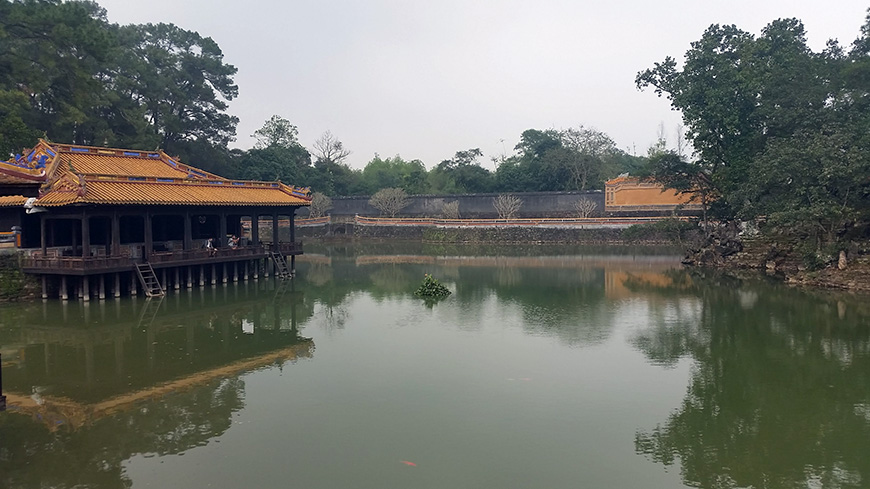
View of the park in Tu Duc's mausoleum - Source : Mr Linh's adventures Team
More Than an Eternal Resting Place
In Vietnamese culture, death is not an end but a transition. The imperial tombs are not just burial places but sites where the living can commune with the spirits of the deceased. They play a crucial role in ancestor worship, a fundamental practice in Vietnamese spirituality.
Imperial Funerals in Vietnam
The funerals of a Nguyen emperor, which could last up to two years, were initiatory journeys steeped in profound spirituality. The body, delicately prepared, was placed in several symbolic coffins. A grand procession then led the coffin to the mausoleum, followed by elaborate rituals to ensure the peaceful passage of the imperial soul to the afterlife.
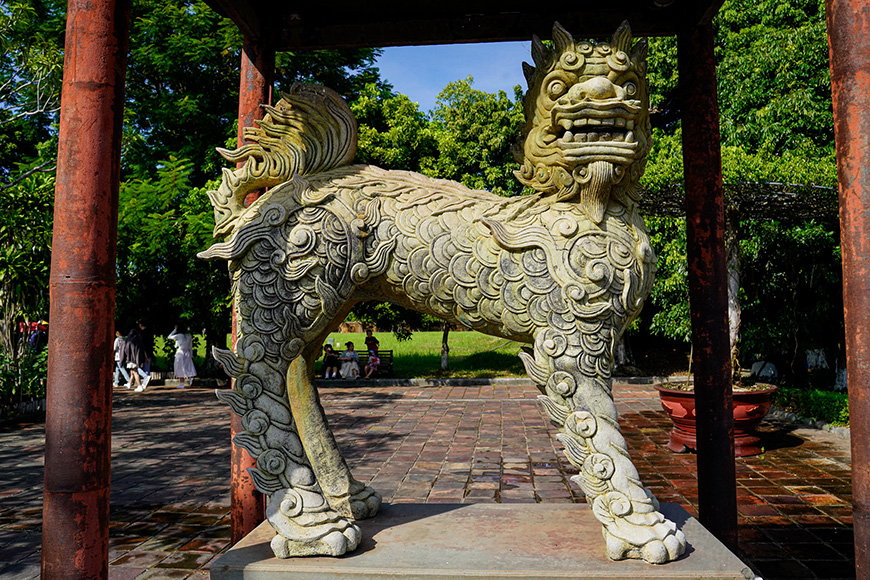
Ky Lan, the Vietnamese Unicorn - Source : Mr Linh's adventures
The Harmony of Feng Shui
The choice of the tomb locations, to the west of the Hue citadel, is not arbitrary. According to Feng Shui principles, this orientation promotes harmony between the world of the living and the world of the dead. The architects carefully selected sites surrounded by protective hills, with a view of water, symbolizing prosperity and continuity.
Some Feng Shui Elements Present in These Tombs
Location
Hills and Mountains: Tombs are often situated on hills, backed by mountains, considered favorable for protection and harmony.
Bodies of Water: They are typically oriented towards bodies of water such as rivers or ponds. This layout is believed to enhance energy flow and bring serenity and prosperity.
Orientation
Westward Direction: Tombs are often oriented westward, in line with the belief that the souls of deceased kings join the setting sun for their eternal rest. This orientation is also linked to the yin-yang theory, where the west is associated with tranquility and peace.
Architecture and Layout
Symmetry and Balance: Tombs are designed with great attention to symmetry, essential in Feng Shui to create a harmonious balance between different components of the space.
Access Paths: Paths leading to the tombs are often winding, symbolizing a peaceful journey to eternal rest, in alignment with Feng Shui principles.
Symbolism
Dragons and Other Motifs: Decorations and sculptures, like those of dragons, are often used to symbolize protection and power, essential elements in Vietnamese culture and Feng Shui.
Did you know? The evolution of funeral rites in Vietnam is a fascinating subject reflecting the country's social, political, and cultural changes.
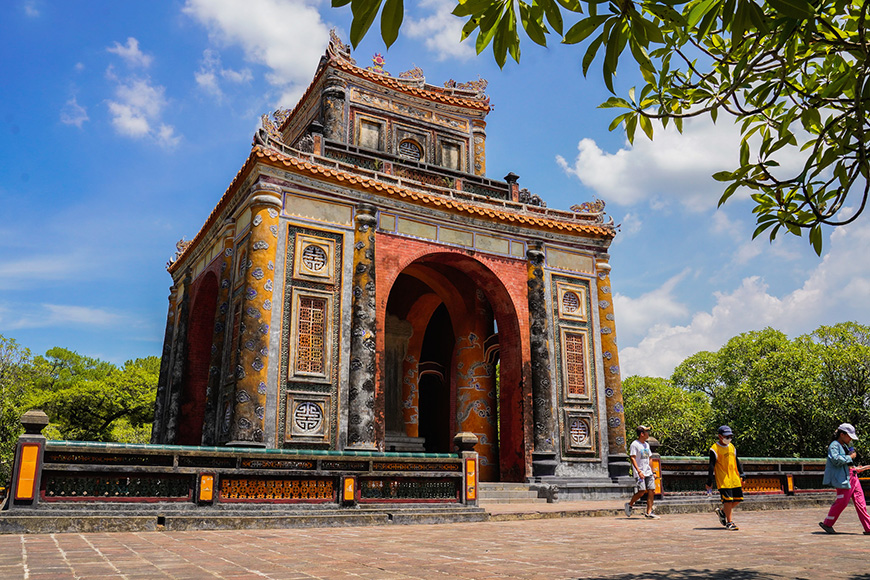
Emperor Tu Duc's tomb - Source : Mr Linh's adventures
Four Imperial Jewels
Tu Duc's Tomb
Emperor Tu Duc, a poet and scholar, had his tomb built during his lifetime between 1864 and 1867. He lived there for several years before his death, writing poetry and composing music. Legend has it that he was buried with his treasures and favorite concubines to accompany him to the afterlife.
- ♦ Located just 5 km southwest of Hue, it is the most easily accessible and visited tomb.
- ♦ Built between 1864 and 1867, it is considered one of the finest examples of Nguyen Dynasty funerary architecture.
- ♦ The tomb stands out for its water features, gardens, and elegant pavilions.
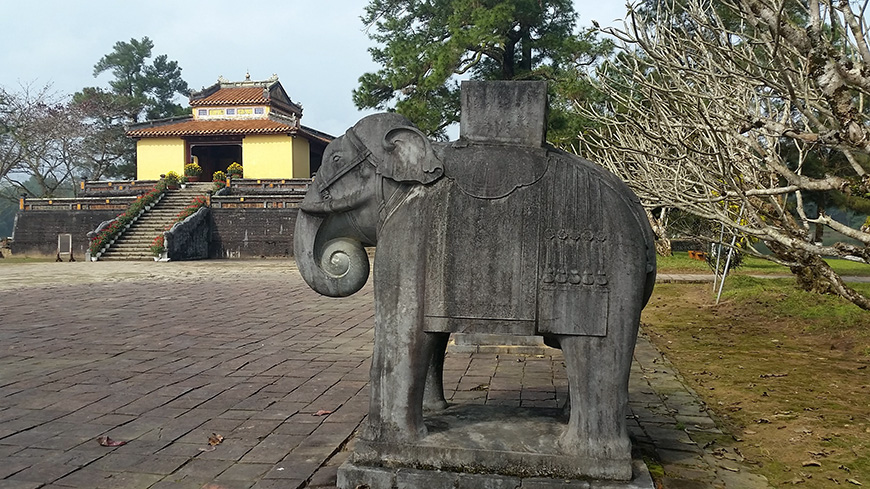
View of Khai Dinh's tomb - Source : Mr Linh's adventures Team
Minh Mang's Tomb
Impressive in its dimensions, this vast funerary complex houses numerous monuments and pavilions. Legend has it that Emperor Minh Mang had an underground banquet hall built to host feasts with his ancestors.
- ♦ Located 12 km east of Hue, this vast funerary complex impresses with its size and architecture.
- ♦ Built between 1840 and 1843, it consists of 40 monuments and pavilions symmetrically arranged on a wooded hill.
- ♦ The architectural style blends Chinese and Vietnamese influences, with refined decorative elements.
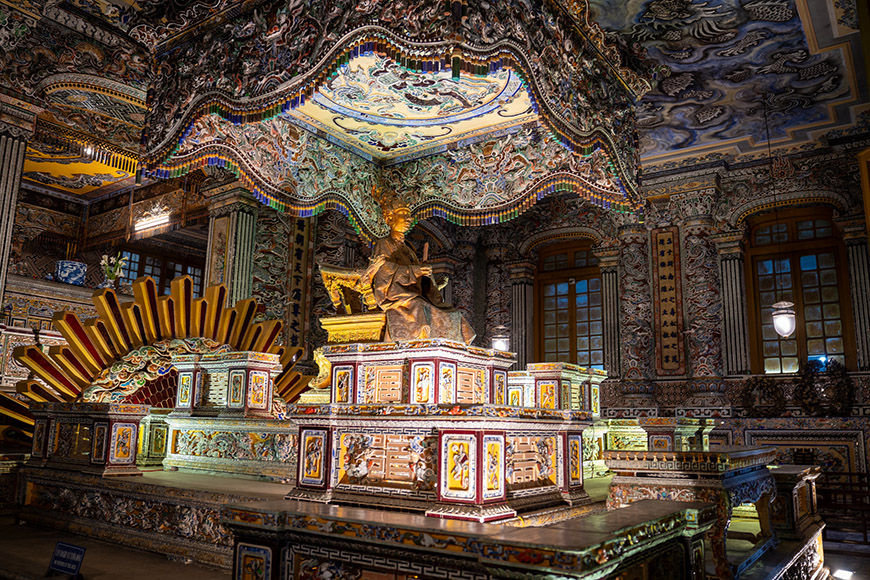
Inside Khai Dinh's tomb - Source : Mr Linh's adventures
Khai Dinh's Tomb
Built between 1920 and 1931, this tomb blends European and Vietnamese influences. Legend has it that Emperor Khai Dinh had a secret tunnel built connecting his tomb to the Forbidden City, allowing discreet access.
- ♦ Perched on Chau Chu Hill 10 km from Hue, this tomb stands out for its unique architectural style.
- ♦ Built between 1920 and 1931, it combines European neoclassical elements and traditional Vietnamese motifs.
- ♦ The interior of the main tomb is covered in mosaics of colored porcelain and glass tiles.
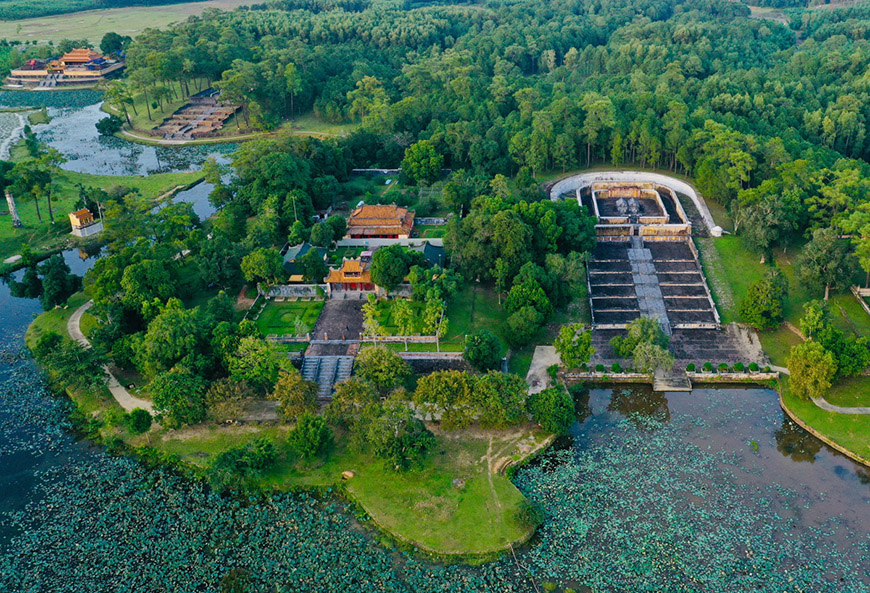
Aerial view of Gia Long's tomb - Source : Internet
Gia Long's Tomb
Located in a splendid natural setting, this tomb is characterized by its simple and majestic style. Legend has it that Emperor Gia Long, the founder of the Nguyen Dynasty, had treasures and weapons buried in the foundations of his tomb to protect his kingdom.
- ♦ Located 30 km northeast of Hue, it is the oldest of the imperial tombs.
- ♦ Built between 1814 and 1820, it is characterized by its simple and majestic style.
- ♦ The tomb is composed of several monuments spread across a wooded hill, with a panoramic view of the Perfume River.
Preserving History
Today, these tombs face the challenges of time and mass tourism. Conservation efforts are underway to preserve these treasures for future generations, balancing accessibility and protection.
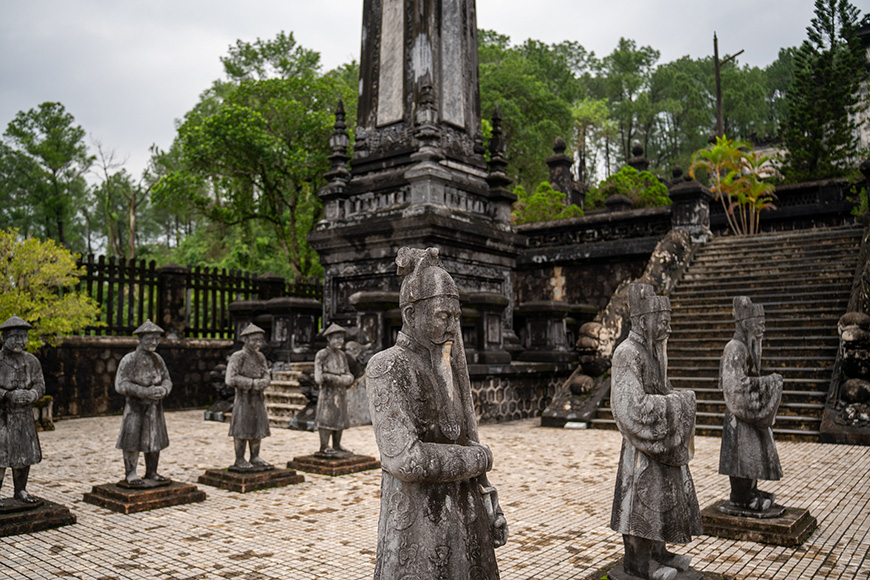
On the forecourt of Khai Dinh's tomb - Source : Mr Linh's adventures
A Bridge Between Worlds
The Imperial Tombs of Hue are more than just historical monuments. They are bridges between the past and the present, between the material and spiritual worlds. By visiting them, you not only discover Vietnam's history but also immerse yourself in its deep culture, beliefs, and worldview.
As you walk through these imperial necropolises, remember that you are treading on sacred ground, rich in history and mystery. Let yourself be carried away by the magic of the places, and perhaps you will hear the distant echoes of a bygone era, never forgotten.
► Discover Hué's must-sees with our tailor-made tours.
Guided tours, comfortable accommodation and authentic experiences await you.